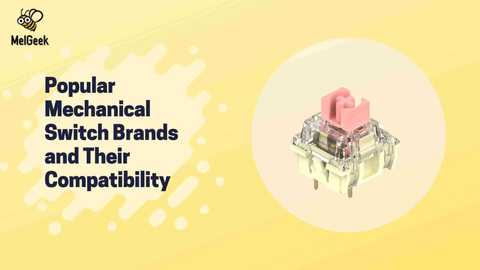Are mechanical keyboard switches universal

Mechanical keyboards are used frequently by gamers as well as typists because of their tactile response and durability. Their mechanism of using one separate mechanical switch for each key is entirely different from membrane keyboards that use rubber domes beneath every key. They are the keys to the feel and sound of each keystroke, providing a customizable typing experience to each user.
Key witches of mechanical keyboards are not interchangeable across all mechanical keyboards. Brands and models use different optic switches, such as Cherry MX, Razer, or Logitech. Each type of switch varies in its actuation force, travel distance, and sound profile. Therefore, when selecting a mechanical keyboard, one has to understand the switch type for pairing the switch with the typing style.
This article looks into the universality of mechanical keyboard switches, by clarifying switch types, compatibility problems, and key caps issues. Its goal is to give readers a better insight into mechanical keyboards and their parts so that they know what they are buying or customizing their keyboard sets. The central question explored here is- are mechanical keyboard switches universal?
Understanding Mechanical Keyboard Switches
A mechanical keyboard switch refers to the mechanism, found under each keycap, that provides tactile feedback and presses the keys. Although they provide great diversity, these switches are also quite different from each other in terms of design and features.
The main components of a mechanical switch usually include the housing, the spring, and the stem. When a key is pressed the stem goes downward and compresses the coil of the spring making an electric terminal, and the input will be sent to the computer.
Mechanical keyboard switches have different types like, linear, tactile, and clicky switches. Linear switches provide a certain smoothness to your keystrokes that eliminates any bumps or clicks sounds. Tactile switches give a slight bump as the key is pressed, and so they suit the needs of a typist who desires a tactile response. However, clicky switches not only have the tactile bump but also make a click sound with each keystroke which is pleasing to some users.
The Concept of Universality in Keyboard Switches
Are keyboard switches universal? Universality of keyboard switches is that you can switch and swap switches from keyboard to keyboard. Quite to the contrary, switch types are not generally compatible with each other. While some mechanical keyboard switches may have the same design or be compatible with certain keycaps, there is no unification across all switches. In essence, every mechanical keyboard switch is not universal, and the compatibility becomes more and more open-ended as the manufacturer as well as the type and specification of the switch are chosen.
Additionally, the question arises - are mechanical keyboard keycaps universal? The frequent misconception is that all mechanical keyboard keycaps are interchangeable. The keycaps may work with all kinds of switches, and however, sometimes it is a problem to fit them because of the different ways they are installed or dimensions. A common issue with switches is the compatibility, and things like stem design, actuation force, construction differ between different keyboard layouts. Compatibility should be studied and verified before keyboard enthusiasts and users mix and match switches.
Factors Influencing Switch Compatibility

When it comes to mechanical keyboards, the idea of universal compatibility might seem appealing. However, several factors influence whether keyboard switches are truly universal.
One important feature is the physical size and shape of the switches. Different switches could have various sizes and can affect how they wanted to place nesting a keyboard casing. This variety implies that not all the switches do not make into all keyboards without changing their design.
Another crucial thing is where the switches will be mounted. Keyboards have both plate mounted and PCB mounted keys, and the difference in this affects the compatibility. Plate mounted switches are mounted on the metal or plastic plate board and PCB mounted switches are soldered onto the PCB of the keyboard. These switches are predesigned to be screwed in a predetermined way, and if one method is not compatible with another different method would be needed to fit the switch.
Are key switches universal? Aside from its wires, the position of the switch is also crucial. Certain key switches have cases which do not match properly with some keycap designs or keyboard layouts. For instance, some key switches with odd shapes and dimensions may not fit properly on the keyboard ones or may not have the specific keycaps.
The backbone of switches is their pin configuration, which also differs between keyboard models, making them to be particular or applicable for some. For some switches three pins are necessary, others have five or may be even more. There are diverse varieties in spring as well as the pin configuration that may be the reason the switches are mounted and wired to the circuitry inappropriately.
Compatibility with Keyboards
Standard mechanical keyboards, the switches usually follow the industry's compatibility norms. This implies that the majority of mechanical keyboard switch alternatives can be changed between keyboards that conform to the mentioned standards. Users can easily replace switches and not be concerned about compatibility because the process is simple enough and no compatibility issues.
Custom mechanical keyboards provide flexibility in switch compatibility. Fans will select from a variety of switches and can almost effortlessly add the switches to their tactile keyboards. This provides a chance for personalized typing that meets individual tastes, be it a gaming, typing, or programming typing experience.
Examples of universal switch compatibility keyboards include models like the Ducky One 2 Mini, the Keychorn K6, and the Glorious GMMK. These keyboards are built to work with combinations of different switches including most of the brands of switches and variety of styles. So, the users are not limited by the compatibility issues anymore.
Compatibility with Keycaps
Are mechanical keycaps universal? The keycap compatibility in mechanical keyboards depends on the keycap profile due to the effect it has on switch selection. Cherry MX switches are commonly found and follow basic structure, and Alps & Topre switches can be more demanding due to their custom configurations of stem sizes and shapes. The choice of the option is also determined by these factors.
The stem type of a switch is of utmost importance in accounting keycap. A switch capable to fit with the stems of the Cherry MX-compatible ones can usually take caps from other producers. Those that fit this standard. However, switches having non-standard stems can restrict the choices of the keycap and the user needs to look for an adapter to make sure that keycap fits properly on them.
Universal vs proprietary keycap stems is one of the most issues in terms of compatibility between keycaps. Offering a universal keyboard platform commonly includes a wider range of keycaps support, but a separate keyboard may force the user to choose a set of keycaps specifically for that model. Knowledge of such differences will better allow the users to make sound choices when modifying their mechanical keyboards for their likings.
Electrical and Connection Compatibility
Mechanical keyboard switches do not have one particular standard that defines all keyboards. The electrical standards for switches may differ greatly from one manufacturer to another as well as from one model to another. This implies that if one keyboard is switched to another then it will not work properly in addition it will just be useless for the other one.
The role of circuit design when it comes to the button compatibility is a matter of great significance. Keyboard designers make all the provisions for there being specific switches and use of an alternate switch that is not compatible with the circuit logic leads to malfunctions or non-functioning keys.
Common conflicts with electrical compatibility include situations where buttons’ inputs are not recorded, there is a ghosting (when unintentional keypresses are detected), or even the damage to the key’s circuit if incompatible switches are forcedly installed. Compatibility of the switches and keycaps is of great importance to avoid these issues.
Popular Mechanical Switch Brands and Their Compatibility

Melgeek mechanical keyboards are versatile and adaptable to most keycaps, and any standard MX-type switch with linear, tactile, and clicky options to pick from. They are frequently used in custom mechanical keyboards because of their stability and meeting the aesthetics of custom keycaps.
The Gateron switches are known for their good strokes and low prices and therefore are used widely by enthusiasts and gamers. There are Red, Brown, Blue, and Black ones. They represent different styles of typing and preferences.
Kailh mechanical switches provide us with a choice of styles, including low-profile, RGB and silent switches. These switches are often used with mechanical keyboards and keycaps that have holes for Cherry MX style switches to fit through. Kailh switches can be a top choice for many for the customization options and their long lives.
Razer mechanical switches, including Razer Green and Razer Yellow, are designed for Razer keyboard and feature a responsiveness and gaming-centric functionality in which they are known for. However, Razer-specific keycaps are not for all, but they work with the company's switches directly, showing their commitment to quality.
Modifying Switches for Better Compatibility
The switch modification could improve their compatibility with the keyboards built around the switches. Customizability applies to even small changes like keycap profiles or types of stem. This makes switching keys more comfortable for various users. This lets the users modify their keyboards to make them fit without worrying about the keycap and switch compatibility. Besides, modifying switches is having some residing positive and negative impacts.
Risk factors include risk of damaging the switch mechanism or rendering warranties invalid, but incentives are upgraded compatibility or better typing experience. Generally, if you do thoughtfully and with an understanding of the process, altering mechanical keyboard switches is a very effective solution to better the experience for the user.
Industry Standards and Their Impact on Universality
The existing mechanical switch in switch design carries a significant amount of weight when it comes to contributing to the universality of keyboard switches. Standards of manufacturers for compatibility include dimensions, point arrangement, and contact force, which cover these parameters across different brands and models. The cherry mx switch standard, widely adopted, offers high commonality among keyboards that have cherry mx switches installed, guaranteeing first-class keyboards is a common approach.
With the rise of the standardization the uniformity of brands is represented in the wide range of mechanical keyboard switches variation. This compatibility returns to keycaps as well, numerous mechanical keycaps are designed to fit universally for switches following established requirements. This type of uniformity assures consumers in selecting mechanical keyboards of different brands with different switches and keycaps without the inconvenience of dealing with the compatibility issues.
Summary
Mechanical switch designs like Cherry MX, Razer, and Gateron differ from one another, thus making it very particular to individual keyboards and keys. These switches are different in the acceptance force, activation point, and tactile feedback properties, which are for particular keyboard models. Consequently, key switch selection has become a determinant in achieving top-notch performance and typing experience.
Mechanical keyboards have advanced at a fast pace, recently introducing additional switch kinds, double-shot PBT or ABS keycaps and RGB lighting, among these modules. This variation provides users with room to invent their own typing environments by having these switches and keycaps that may not be everywhere compatible. These creates ability to consistently upgrade and improve the mechanical keyboard community shows how diverse these keyboards can be and how individuals can customize them to suit their unique needs.
FAQs
Are all mechanical switches interchangeable?
No, mechanical switches are not all the same, as the keyboards you use could accommodate different switch types.
What do I need to check before buying switches for my keyboard?
Before making the purchase, make sure that the switches match the socket type of your keyboard, including the mounting style and size.
Can I use any switch with any keycap?
Usually, the most typical keycaps can be shifted among switches of the same stem design (e.g. Cherry MX-compatible).
What are the risks of using incompatible switches in my keyboard?
Risks of a switch being incompatible with a given keyboard are keycap wobble, insufficient key registration, or even damage to the board itself.
Where can I find compatibility information for specific switches and keyboards?
Seek compatibility information by visiting the product manufacturer's website, online forums, or by engaging with keyboard enthusiasts and technical experts.



